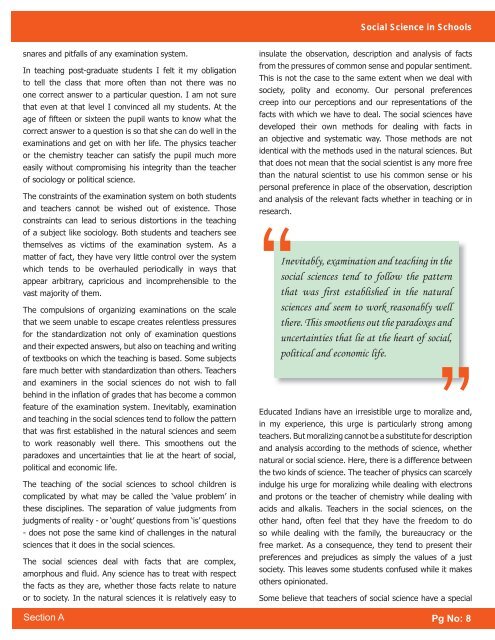Indesign Pagesnew.indd - Azim Premji Foundation
Indesign Pagesnew.indd - Azim Premji Foundation
Indesign Pagesnew.indd - Azim Premji Foundation
You also want an ePaper? Increase the reach of your titles
YUMPU automatically turns print PDFs into web optimized ePapers that Google loves.
snares and pitfalls of any examination system.<br />
In teaching post-graduate students I felt it my obligation<br />
to tell the class that more often than not there was no<br />
one correct answer to a particular question. I am not sure<br />
that even at that level I convinced all my students. At the<br />
age of fi fteen or sixteen the pupil wants to know what the<br />
correct answer to a question is so that she can do well in the<br />
examinations and get on with her life. The physics teacher<br />
or the chemistry teacher can satisfy the pupil much more<br />
easily without compromising his integrity than the teacher<br />
of sociology or political science.<br />
The constraints of the examination system on both students<br />
and teachers cannot be wished out of existence. Those<br />
constraints can lead to serious distortions in the teaching<br />
of a subject like sociology. Both students and teachers see<br />
themselves as victims of the examination system. As a<br />
matter of fact, they have very little control over the system<br />
which tends to be overhauled periodically in ways that<br />
appear arbitrary, capricious and incomprehensible to the<br />
vast majority of them.<br />
The compulsions of organizing examinations on the scale<br />
that we seem unable to escape creates relentless pressures<br />
for the standardization not only of examination questions<br />
and their expected answers, but also on teaching and writing<br />
of textbooks on which the teaching is based. Some subjects<br />
fare much better with standardization than others. Teachers<br />
and examiners in the social sciences do not wish to fall<br />
behind in the infl ation of grades that has become a common<br />
feature of the examination system. Inevitably, examination<br />
and teaching in the social sciences tend to follow the pattern<br />
that was fi rst established in the natural sciences and seem<br />
to work reasonably well there. This smoothens out the<br />
paradoxes and uncertainties that lie at the heart of social,<br />
political and economic life.<br />
The teaching of the social sciences to school children is<br />
complicated by what may be called the ‘value problem’ in<br />
these disciplines. The separation of value judgments from<br />
judgments of reality - or ‘ought’ questions from ‘is’ questions<br />
- does not pose the same kind of challenges in the natural<br />
sciences that it does in the social sciences.<br />
The social sciences deal with facts that are complex,<br />
amorphous and fl uid. Any science has to treat with respect<br />
the facts as they are, whether those facts relate to nature<br />
or to society. In the natural sciences it is relatively easy to<br />
Section A<br />
Social Science in Schools<br />
insulate the observation, description and analysis of facts<br />
from the pressures of common sense and popular sentiment.<br />
This is not the case to the same extent when we deal with<br />
society, polity and economy. Our personal preferences<br />
creep into our perceptions and our representations of the<br />
facts with which we have to deal. The social sciences have<br />
developed their own methods for dealing with facts in<br />
an objective and systematic way. Those methods are not<br />
identical with the methods used in the natural sciences. But<br />
that does not mean that the social scientist is any more free<br />
than the natural scientist to use his common sense or his<br />
personal preference in place of the observation, description<br />
and analysis of the relevant facts whether in teaching or in<br />
research.<br />
Inevitably, examination and teaching in the<br />
social sciences tend to follow the pattern<br />
that was fi rst established in the natural<br />
sciences and seem to work reasonably well<br />
there. This smoothens out the paradoxes and<br />
uncertainties that lie at the heart of social,<br />
political and economic life.<br />
Educated Indians have an irresistible urge to moralize and,<br />
in my experience, this urge is particularly strong among<br />
teachers. But moralizing cannot be a substitute for description<br />
and analysis according to the methods of science, whether<br />
natural or social science. Here, there is a difference between<br />
the two kinds of science. The teacher of physics can scarcely<br />
indulge his urge for moralizing while dealing with electrons<br />
and protons or the teacher of chemistry while dealing with<br />
acids and alkalis. Teachers in the social sciences, on the<br />
other hand, often feel that they have the freedom to do<br />
so while dealing with the family, the bureaucracy or the<br />
free market. As a consequence, they tend to present their<br />
preferences and prejudices as simply the values of a just<br />
society. This leaves some students confused while it makes<br />
others opinionated.<br />
Some believe that teachers of social science have a special<br />
Pg No: 8

















